Source Apportionment of Air Quality Parameters and Noise Levels in the Industrial Zones of Blantyre City
Abstract
:1. Introduction
2. Materials and Methods
2.1. Description of Study Area
2.2. Air Monitoring
2.3. Noise Monitoring
2.4. Data Analysis
3. Results
3.1. Air Quality Parameters and Noise Levels
3.1.1. Carbon Monoxide (CO) Concertation Levels
3.1.2. Total Suspended Particle Concertation Levels
3.1.3. PM10 Concertation Levels
3.1.4. Particulate Matter 2.5 Concentration Levels
3.1.5. Noise Levels
3.2. Source Apportionment (Examination of Sources) for Air Quality Parameters from the Industrial Areas
| S/N Values | ||
|---|---|---|
| Species | Dry Season | Wet Season |
| CO | 0.609 | 0.091 |
| TSP | 3.693 | 1.843 |
| PM10 | 2.426 | 2.314 |
| PM2.5 | 2.466 | 1.528 |
3.3. Correlation between Air Quality Parameters and Noise Levels
4. Conclusions
Recommendations
Author Contributions
Funding
Institutional Review Board Statement
Informed Consent Statement
Data Availability Statement
Acknowledgments
Conflicts of Interest
Appendix A
Appendix A.1. Table of Coordinates for Sampling Points
| Sampling Points | Geographical Coordinate System | |
| Maone Industrial Area | (Latitude, Longitude) | (UTM) |
| Maone OF | −15.79248, 35.07676 | 722,465.48, 8,252,921.50 |
| Maone MH | −15.78429, 35.07958 | 722,776.63, 8,253,824.17 |
| Maone NM | −15.78332, 35.07571 | 722,362.96, 8,253,936.39 |
| Makata Industrial Area | ||
| Makata LF | −15.79132, 35.02744 | 717,182.33, 8,253,101.41 |
| Makata AP | −15.79029, 35.02339 | 716,748.68, 8,253,219.58 |
| Makata CM | −15.78641, 35.03355 | 717,841.57, 8,253,638.50 |
| Chirimba Industrial Area | ||
| Chirimba AP | −15.73752, 35.03059 | 717,577.34, 8,259,052.29 |
| Chirimba BC | −15.74260, 35.03074 | 717,587.15, 8,258,489.82 |
| Chirimba VZ | −15.74120, 35.02713 | 717,201.70; 8,258,647.93 |
| Limbe Industrial Area | ||
| Limbe AZ | −15.80686, 35.06551 | 721,243.21, 8,251,341.22 |
| Limbe MP | −15.80755, 35.06737 | 721,442.83, 8,251,262.55 |
| Limbe PC | −15.80511, 35.06359 | 721,442.83, 8,251,536.57 |
| Maselema Industrial Area | ||
| Maselema PP | −15.80506, 35.05091 | 719,681.90, 8,251,556.40 |
| Maselema RP | −15.80405, 35.05219 | 719,820.04, 8,251,666.62 |
| Maselema BP | −15.80644, 35.05758 | 720,395.01, 8,251,396.02 |
Appendix A.2. Statistical Analysis (Seasonal Variations Using Paired t-Test)
| Mean Difference | Confidence Interval | t | df | Stderr | p-Value (α = 0.05) | ||
| Variable | lower | upper | |||||
| CO | −0.824 | −1.491 | −0.158 | −2.494 | 44 | 0.3306125 | 0.01647 |
| TSP | −9.507 | −49.941 | 30.928 | −0.474 | 44 | 20.06316 | 0.638 |
| PM10 | −10.418 | −15.950 | −4.885 | −3.795 | 44 | 2.745143 | 0.0004478 |
| PM2.5 | −7.262 | −11.612 | −2.912 | −3.3644 | 44 | 2.158538 | 0.001599 |
| Noise | −4.493 | −7.075 | −1.912 | −3.508 | 44 | 1.280761 | 0.001053 |
References
- Russell, V.S. Pollution: Concept and definition. In Biological Conservation, 3rd ed.; Australian National University: Canbera, Australia, 1974; Volume 6, pp. 157–161. [Google Scholar] [CrossRef]
- Thulu, F.G.D.; Tembo, D.; Nyirongo, R.; Mzaza, P.J.C.; Kamfosi, A.; Mawenda, U.C. Electromagnetic Frequency Pollution in Malawi: A Case of Electric Field and Magnetic Flux Density Pollution in Southern Africa. Int. J. Environ. Res. Public Health 2023, 20, 4413. [Google Scholar] [CrossRef] [PubMed]
- Assanov, D.; Zapasnyi, V.; Kerimray, A. Air quality and industrial emissions in the cities of Kazakhstan. Atmosphere 2021, 12, 314. [Google Scholar] [CrossRef]
- Hsu, C.Y.; Chi, K.H.; Wu, C.D.; Lin, S.L.; Hsu, W.C.; Tseng, C.C.; Chen, M.J.; Chen, Y.C. Integrated analysis of source-specific risks for PM2.5-bound metals in urban, suburban, rural, and industrial areas. Environ. Pollut. 2021, 275, 116652. [Google Scholar] [CrossRef] [PubMed]
- Manojkumar, N.; Basha, K.; Srimuruganandam, B. Assessment, Prediction and Mapping of Noise Levels in Vellore City, India. Noise Mapp. 2019, 6, 38–51. [Google Scholar] [CrossRef]
- Bai, L.; Wang, J.; Ma, X.; Lu, H. Air pollution forecasts: An overview. Int. J. Environ. Res. Public Health 2018, 4, 780. [Google Scholar] [CrossRef] [PubMed]
- World Bank. Malawi Country Environmental Analysis. Malawi Country Environmental Analysis; World Bank: Pretoria, South Africa, 2019. [Google Scholar] [CrossRef]
- Lv, B.; Liu, Y.; Yu, P.; Zhang, B.; Bai, Y. Characterizations of PM2.5 pollution pathways and sources analysis in four large cities in China. Aerosol Air Qual. Res. 2015, 5, 1836–1843. [Google Scholar] [CrossRef]
- Maqsood, N.; Younes, I.; Minallah, M.N. Industrial Noise Pollution and Its Impact on the Hearing Capacity of Workers: A Case Study of Gujranwala City, Pakistan. Int. J. Econ. Environ. Geol. 2019, 2, 45–49. [Google Scholar] [CrossRef]
- Osei, F.A.; Effah, E.A. Health Effects caused by Noise—The Case of Africa: Evidence in Literature from the Past 25 Years. Asian J. Adv. Res. Rep. 2022, 16, 19–27. [Google Scholar] [CrossRef]
- Chirwa, I.; Mlatho, J.S.; Kamunda, C.; Mikeka, C. Assessment of noise levels in heavy and light industries in Blantyre City, Malawi. Malawi J. Sci. Technol. 2019, 1, 73–92. [Google Scholar]
- Sun, Y.; Tian, Y.; Xue, Q.; Jia, B.; Wei, Y.; Song, D.; Huang, F.; Feng, Y. Source-specific risks of synchronous heavy metals and PAHs in inhalable particles at different pollution levels: Variations and health risks during heavy pollution. Environ. Int. 2021, 146, 106162. [Google Scholar] [CrossRef]
- Nazzal, Y.; Orm, N.B.; Barbulescu, A.; Howari, F.; Sharma, M.; Badawi, A.E.; Al-Taani, A.A.; Iqbal, J.; Ktaibi, F.E.; Xavier, C.M.; et al. Study of atmospheric pollution and health risk assessment: A case study for the sharjah and ajman emirates (uae). Atmosphere 2021, 11, 1442. [Google Scholar] [CrossRef]
- Wang, Y.; Guo, G.; Zhang, D.; Lei, M. An integrated method for source apportionment of heavy metal(loid)s in agricultural soils and model uncertainty analysis. Environ. Pollut. 2021, 276, 116666. [Google Scholar] [CrossRef] [PubMed]
- Mapoma, H.W.T.; Xie, X. State of Air Quality in Malawi. J. Environ. Prot. 2013, 4, 1258–1264. [Google Scholar] [CrossRef]
- Tilley, E.; Chilunga, H.; Kwangulero, J.; Schöbitz, L.; Vijay, S.; Heilgendorff, H.; Kalina, M. “It is unbearable to breathe here”: Air quality, open incineration, and misinformation in Blantyre, Malawi. Front. Public Health 2023, 11, 1242726. [Google Scholar] [CrossRef]
- Saleh, S.; Sambakunsi, H.; Mortimer, K.; Morton, B.; Kumwenda, M.; Rylance, J.; Chinouya, M. Exploring smoke: An ethnographic study of air pollution in rural Malawi. BMJ Glob. Health 2021, 6, e004970. [Google Scholar] [CrossRef] [PubMed]
- Commonwealth Network. Available online: https://www.commonwealthofnations.org/about-us-commonwealth-network/ (accessed on 14 January 2024).
- National Statistical Office. Malawi Population and Housing Census Main Report. Malawi Population and Housing Census Report. Government of Malawi, Zomba, 2019; Issue May, pp. 138–172. Available online: https://malawi.unfpa.org/sites/default/files/resource-pdf/2018%20Malawi%20Population%20and%20Housing%20Census%20Main%20Report%20%281%29.pdf (accessed on 28 December 2023).
- BCA (Blantyre City Assembly). A Profile of Industries under Pollution Monitoring Programme of Blantyre City Assembly; BCA: Blantyre, Malawi, 2006. [Google Scholar]
- Drager. Available online: www.draeger.co.uk (accessed on 14 January 2024).
- MSB. Industrial Emissions-Emission from Mobile Sources and Stationary Sources_ Specification, 3rd ed.; Malawi Standards Board: Blantyre, Malawi, 2021. [Google Scholar]
- CastleGroupLtd. Operating Manual: Pocket Sound level Meter Range (GA213, GA215 and GA256); CastleGroupLtd.: Scarborough, England, 2014. [Google Scholar]
- Malawi Standards- MS 697:2021; Industrial Noise Affecting Mixed Residential and Industrial Areas for Rating, 3rd ed. Malawi Standards Board: Blantyre, Malawi, 2021.
- Integrated Development for R. RStudio, Inc. Available online: http://www.rstudio.com (accessed on 14 January 2024).
- Campos, P.M.D.; Esteves, A.F.; Leitão, A.A.; Pires, J.C.M. Design of air quality monitoring network of Luanda, Angola: Urban air pollution assessment. Atmos. Pollut. Res. 2021, 8, 101128. [Google Scholar] [CrossRef]
- USEPA. EPA Positive Matrix Factorization (PMF) 5.0 Fundamentals and User Guide; U.S. Environment Protection Agency: Washington, DC, USA, 2014.
- Guan, Q.; Wang, L.; Wang, F.; Pan, B.; Song, N.; Li, F.; Lu, M. Phosphorus in the catchment of high sediment load river: A case of the Yellow River, China. Sci. Total Environ. 2016, 572, 660–670. [Google Scholar] [CrossRef] [PubMed]
- World Health Organization. WHO Global Air Quality Guidelines. Particulate Matter (PM2.5 and PM10), Ozone, Nitrogen Dioxide, Sulfur Dioxide and Carbon Monoxide; WHO: Geneva, Switzerland, 2021.
- Berglund, B.; Lindvall, T.; Schwela, D.H. New Who Guidelines for Community Noise. Noise Vib. Worldw. 2000, 4, 24–29. [Google Scholar] [CrossRef]
- Ukpebor, J.E.; Omagamre, E.W.; Bamidele, A.; Unuigbe, C.A.; Dibie, E.N.; Ukpebor, E.E. Impacts of improved traffic control measures on air quality and noise level in Benin City, Nigeria. Malawi J. Sci. Technol. 2021, 2, 51–83. Available online: https://www.ajol.info/index.php/mjst/article/view/218545 (accessed on 17 April 2024).
- Sarpong, S.A.; Donkoh, R.F.; Konnuba, J.K.; Ohene-agyei, C.; Lee, Y. Analysis of PM2.5, PM10, and Total Suspended Particle Exposure in the Tema Metropolitan Area of Ghana. Atmosphere 2021, 12, 700. [Google Scholar] [CrossRef]
- Sabuti, A.A.; Mohamed, C.A.R. Correlation between total suspended particles and natural radionuclide in malaysia maritime air during haze event in june-july 2009. J. CleanWAS 2018, 1, 1–5. [Google Scholar] [CrossRef]
- Rovira, J.; Domingo, J.L.; Schuhmacher, M. Air quality, health impacts and burden of disease due to air pollution (PM10, PM2.5, NO2 and O3): Application of AirQ+ model to the Camp de Tarragona County (Catalonia, Spain). Sci. Total Environ. 2020, 703, 135538. [Google Scholar] [CrossRef]
- Jayadipraja, E.; Daud, A.; Assegaf, A.; Maming, M. The application of the AERMOD model in the environmental health to identify the dispersion area of total suspended particulate from cement industry stacks. Int. J. Res. Med. Sci. 2016, 4, 2044–2049. [Google Scholar] [CrossRef]
- Olatunde, K.A.; Sosanya, P.A.; Bada, B.S.; Ojekunle, Z.O.; Abdussalaam, S.A. Distribution and ecological risk assessment of heavy metals in soils around a major cement factory, Ibese, Nigeria. Sci. Afr. 2020, 9, e00496. [Google Scholar] [CrossRef]
- Egbe, E.R.; Chinyere Nsonwu-Anyanwu, A.; Offor, S.J.; Opara Usoro, C.A.; Etukudo, M.H. Heavy metal content of the soil in the vicinity of the united cement factory in Southern Nigeria. J. Adv. Environ. Health Res. 2019, 7, 122–130. [Google Scholar] [CrossRef]
- Zhu, T.; Tang, M.; Gao, M.; Bi, X.; Cao, J.; Che, H.; Chen, J.; Ding, A.; Fu, P.; Gao, J.; et al. Recent Progress in Atmospheric Chemistry Research in China: Establishing a Theoretical Framework for the “Air Pollution Complex”. Adv. Atmos. Sci. 2023, 40, 1339–1361. [Google Scholar] [CrossRef]
- Anderson, B.; Bartlett, K.; Frolking, S.; Hayhoe, K.; Jenkins, J.; Salas, W. Methane and Nitrous Oxide Emissions from Natural Sources. 194. 2010. Available online: https://nepis.epa.gov/Exe/ZyNET.exe/P100717T.txt?ZyActionD=ZyDocument&Client=EPA&Index=2006%20Thru%202010&Docs=&Query=&Time=&EndTime=&SearchMethod=1&TocRestrict=n&Toc=&TocEntry=&QField=&QFieldYear=&QFieldMonth=&QFieldDay=&UseQField=&IntQFieldOp=0&ExtQFieldOp=0&XmlQuery=&File=D%3A%5CZYFILES%5CINDEX%20DATA%5C06THRU10%5CTXT%5C00000017%5CP100717T.txt&User=ANONYMOUS&Password=anonymous&SortMethod=h%7C-&MaximumDocuments=1&FuzzyDegree=0&ImageQuality=r75g8/r75g8/x150y150g16/i425&Display=hpfr&DefSeekPage=x&SearchBack=ZyActionL&Back=ZyActionS&BackDesc=Results%20page&MaximumPages=1&ZyEntry=22&slide (accessed on 12 November 2023).
- Chen, R.; Pan, G.; Zhang, Y.; Xu, Q.; Zeng, G.; Xu, X.; Chen, B.; Kan, H. Ambient carbon monoxide and daily mortality in three Chinese cities: The China Air Pollution and Health Effects Study (CAPES). Sci. Total Environ. 2011, 23, 4923–4928. [Google Scholar] [CrossRef] [PubMed]
- Ho, K.F.; Lee, S.C.; Chan, C.K.; Yu, J.C.; Chow, J.C.; Yao, X.H. Characterization of chemical species in PM2.5 and PM10 aerosols in Hong Kong. Atmos. Environ. 2003, 37, 31–39. [Google Scholar] [CrossRef]
- Sun, S.; Li, L.; Wu, Z.; Gautam, A.; Li, J.; Zhao, W. Variation of industrial air pollution emissions based on VIIRS thermal anomaly data. Atmos. Res. 2020, 244, 105021. [Google Scholar] [CrossRef]
- Yuan, N.; Zhang, J.; Lu, J.; Liu, H.; Sun, P. Analysis of inhalable dust produced in manufacturing of wooden furniture. BioResources 2014, 4, 7257–7266. [Google Scholar] [CrossRef]
- Zheng, H.; Xu, L. Production, and consumption—based primary PM2.5 emissions: Empirical analysis from China’s interprovincial trade. Resour. Conserv. Recycl. 2020, 155, 104661. [Google Scholar] [CrossRef]
- Ro’in, F.; Raharjo, M.; Setiani, O. Association Between PM2.5 Wood Dust Exposure and Acute Respiratory Infection on Plywood Industry Workers in PT. Muara Kayu Sengon, Jatilawang District, Banyumas Regency. In Proceedings of the E3S Web of Conferences, Semarang, Indonesia, 8–9 August 2023; EDP Sciences: Les Ulis, France, 2023; Volume 448, p. 05009. [Google Scholar]
- Yusuf, S.Y.; Rahim, N.A.A.A.; Wazam, W.Z.; Naidu, D.; Jamian, R. Indoor and outdoor particulate matter concentrations in the vicinity of plastic waste processing industries. IOP Conf. Ser. Earth Environ. Sci. 2020, 1, 1–9. [Google Scholar] [CrossRef]
- Alves, C.A.; Evtyugina, M.; Vicente, A.M.P.; Vicente, E.D.; Nunes, T.V.; Silva, P.M.A.; Querol, X. Chemical profiling of PM10 from urban road dust. Sci. Total Environ. 2018, 634, 41–51. [Google Scholar] [CrossRef] [PubMed]
- Chirino, Y.I.; Sánchez-Pérez, Y.; Osornio-Vargas, Á.R.; Rosas, I.; García-Cuellar, C.M. Sampling and composition of airborne particulate matter (PM10) from two locations of Mexico City. Data Brief 2015, 4, 353–356. [Google Scholar] [CrossRef] [PubMed]
- Ashrafi, K.; Fallah, R.; Hadei, M.; Yarahmadi, M.; Shahsavani, A. Source Apportionment of Total Suspended Particles (TSP) by Positive Matrix Factorization (PMF) and Chemical Mass Balance (CMB) Modeling in Ahvaz, Iran. Arch. Environ. Contam. Toxicol. 2018, 2, 278–294. [Google Scholar] [CrossRef]
- Sonibare, J.A.; Akeredolu, F.A.; Osibanjo, O.; Latinwo, I. ED-XRF analysis of total suspended particulates from enamelware manufacturing industry. Am. J. Appl. Sci. 2015, 2, 573–578. [Google Scholar] [CrossRef]
- Guo, Y.; Gao, X.; Zhu, T.; Luo, L.; Zheng, Y. Chemical profiles of PM emitted from the iron and steel industry in northern China. Atmos. Environ. 2017, 150, 187–197. [Google Scholar] [CrossRef]
- Jornet-Martínez, N.; Bocanegra-Rodríguez, S.; González-Fuenzalida, R.A.; Molins-Legua, C.; Campíns-Falcó, P. In Situ Analysis Devices for Estimating the Environmental Footprint in Beverages Industry. Process. Sustain. Beverages 2019, 2, 275–317. [Google Scholar] [CrossRef]
- Jadoon, S.; Nawazish, S.; Mahmood, Q.; Rafique, A.; Sohail, S.; Zaidi, A. Exploring health impacts of occupational exposure to carbon monoxide in the labour community of hattar industrial estate. Atmosphere 2022, 13, 406. [Google Scholar] [CrossRef]
- Lacerda, A.; Leroux, T.; Gagn, J.P. The combined effect of noise and carbon monoxide on hearing thresholds of exposed workers. J. Acoust. Soc. Am. 2005, 4, 2481. [Google Scholar] [CrossRef]
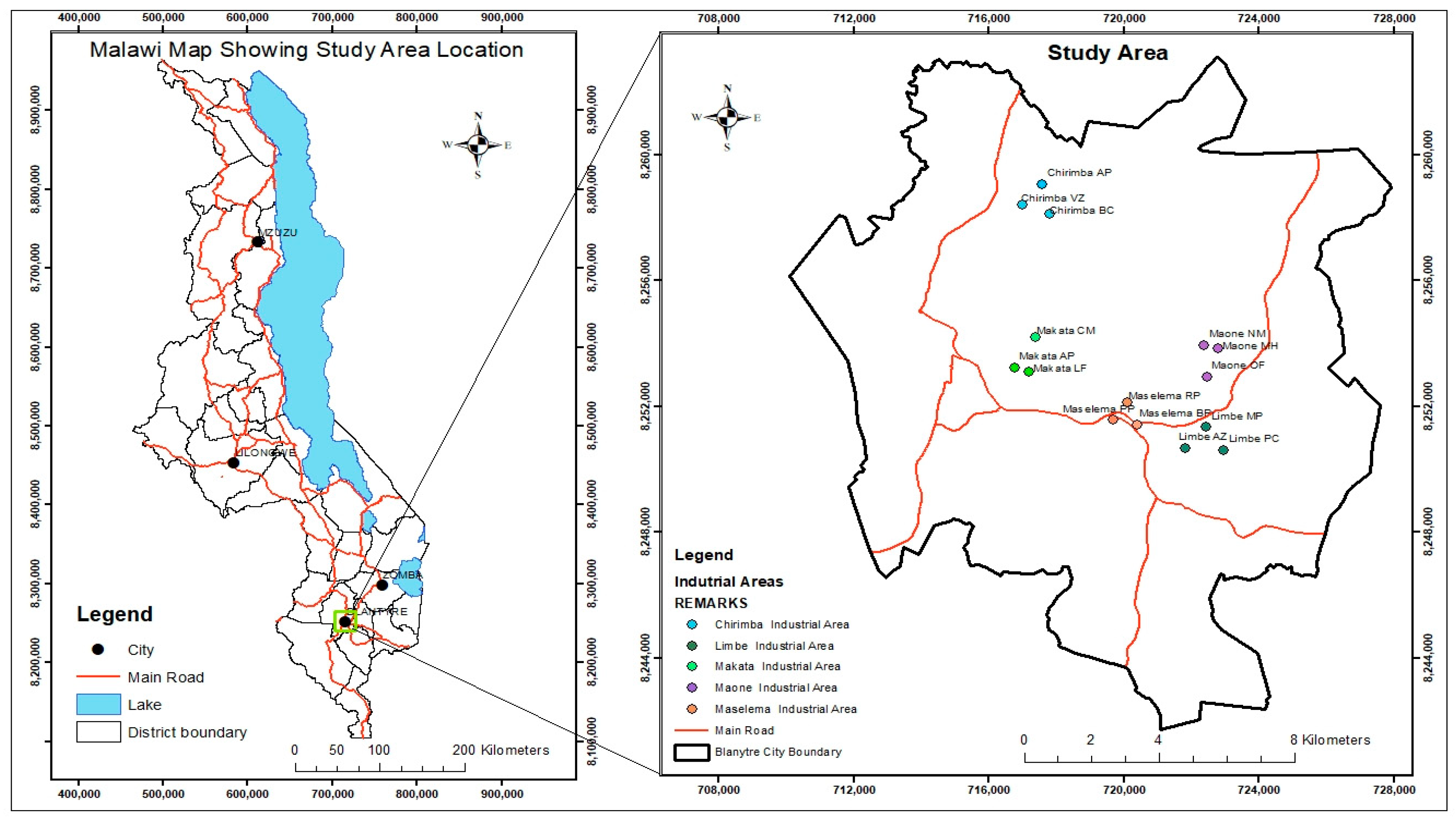

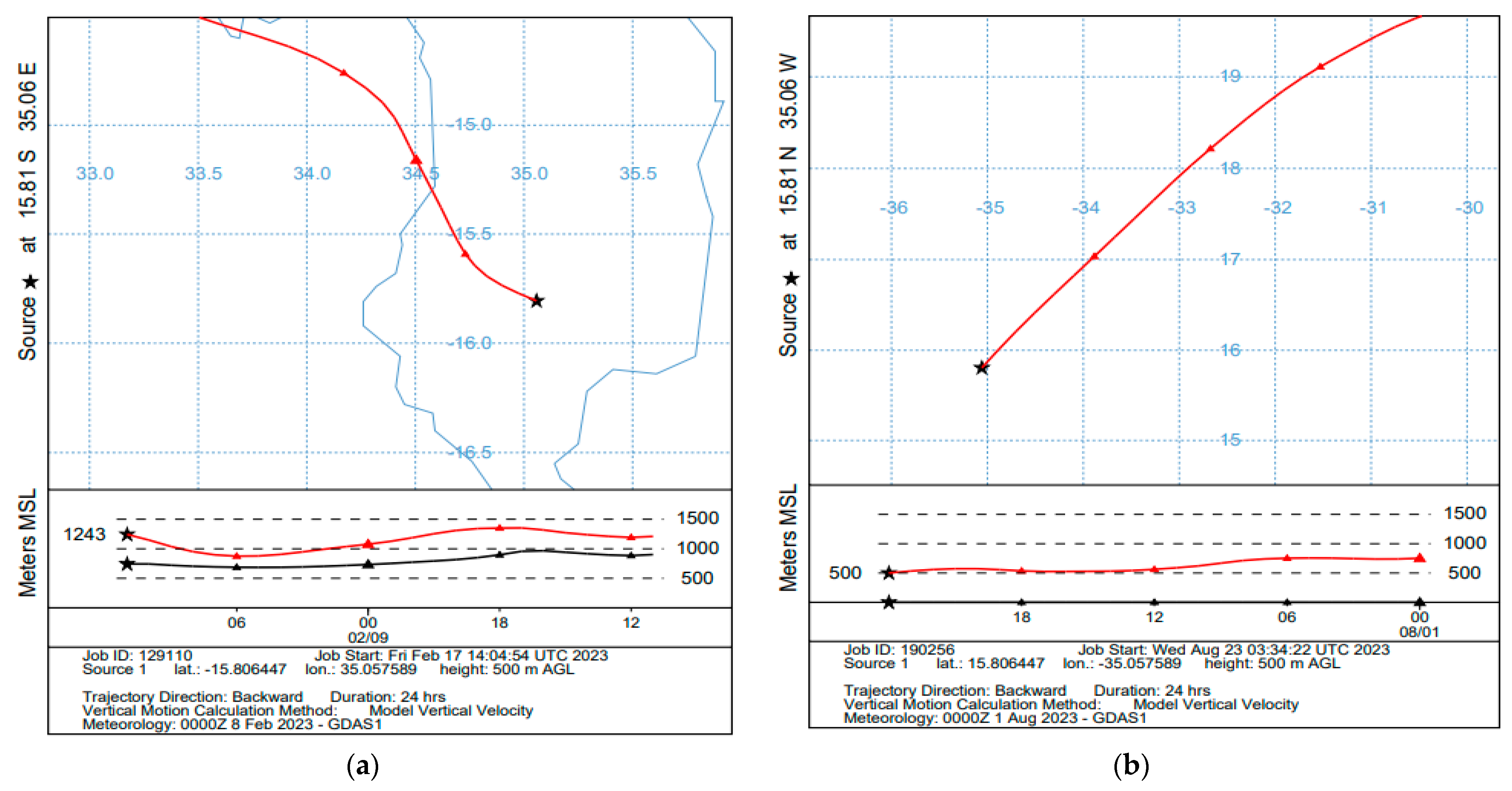

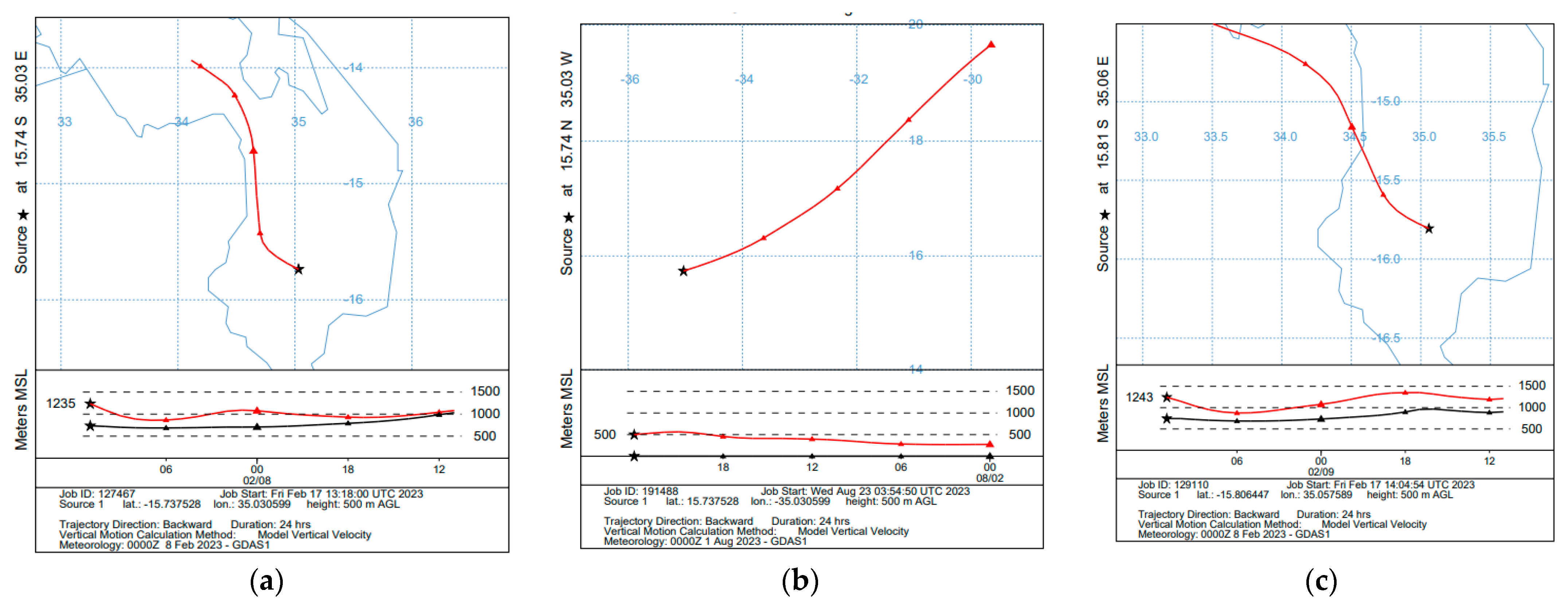
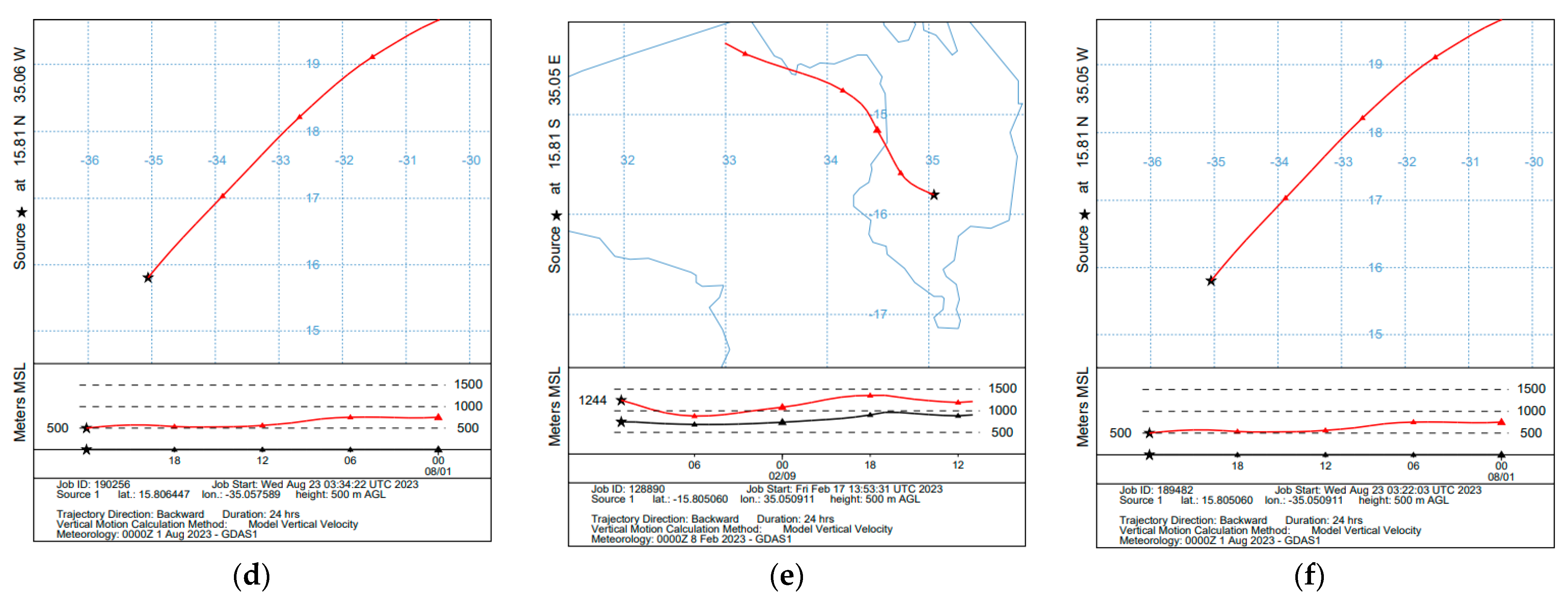

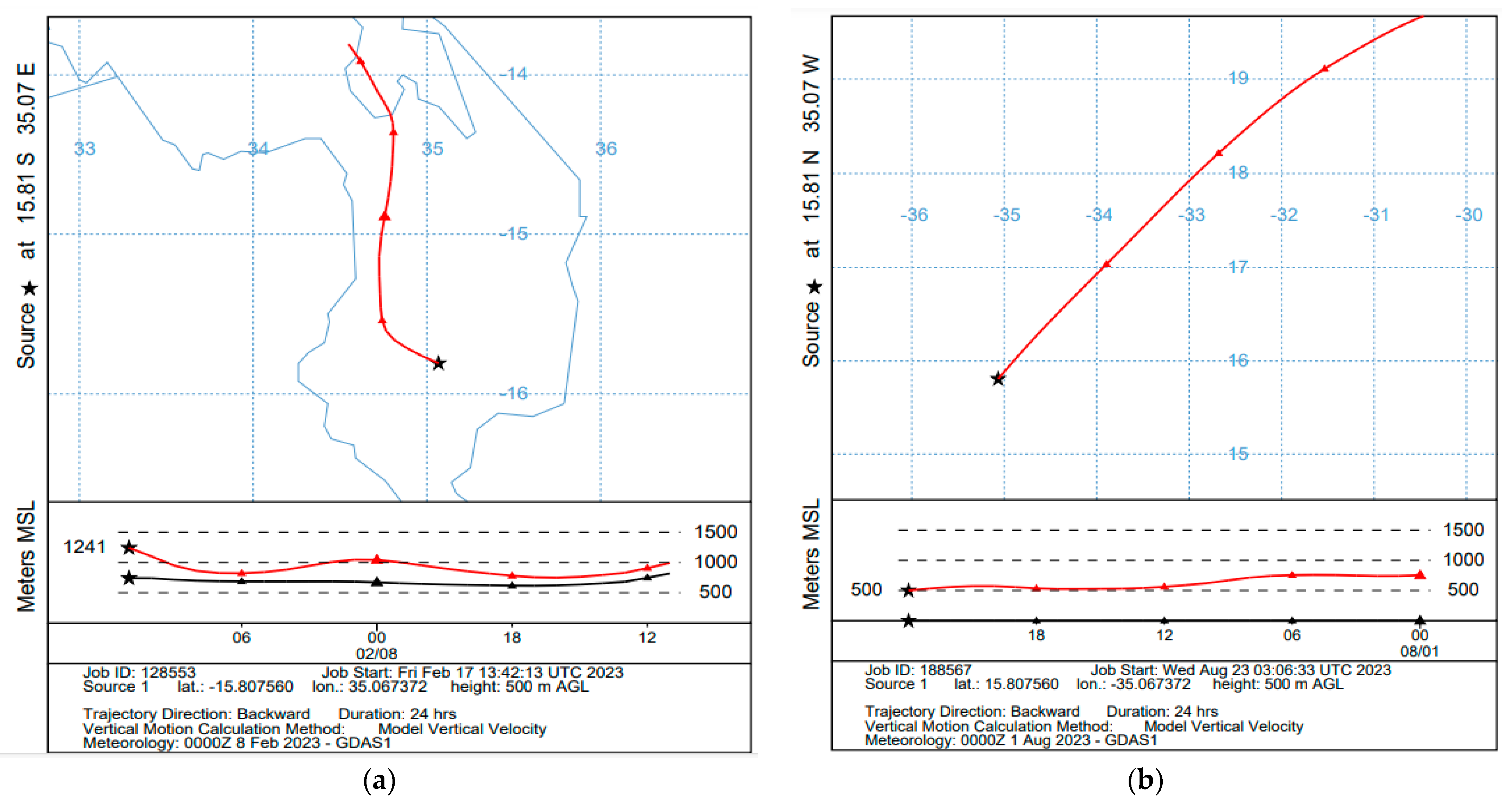
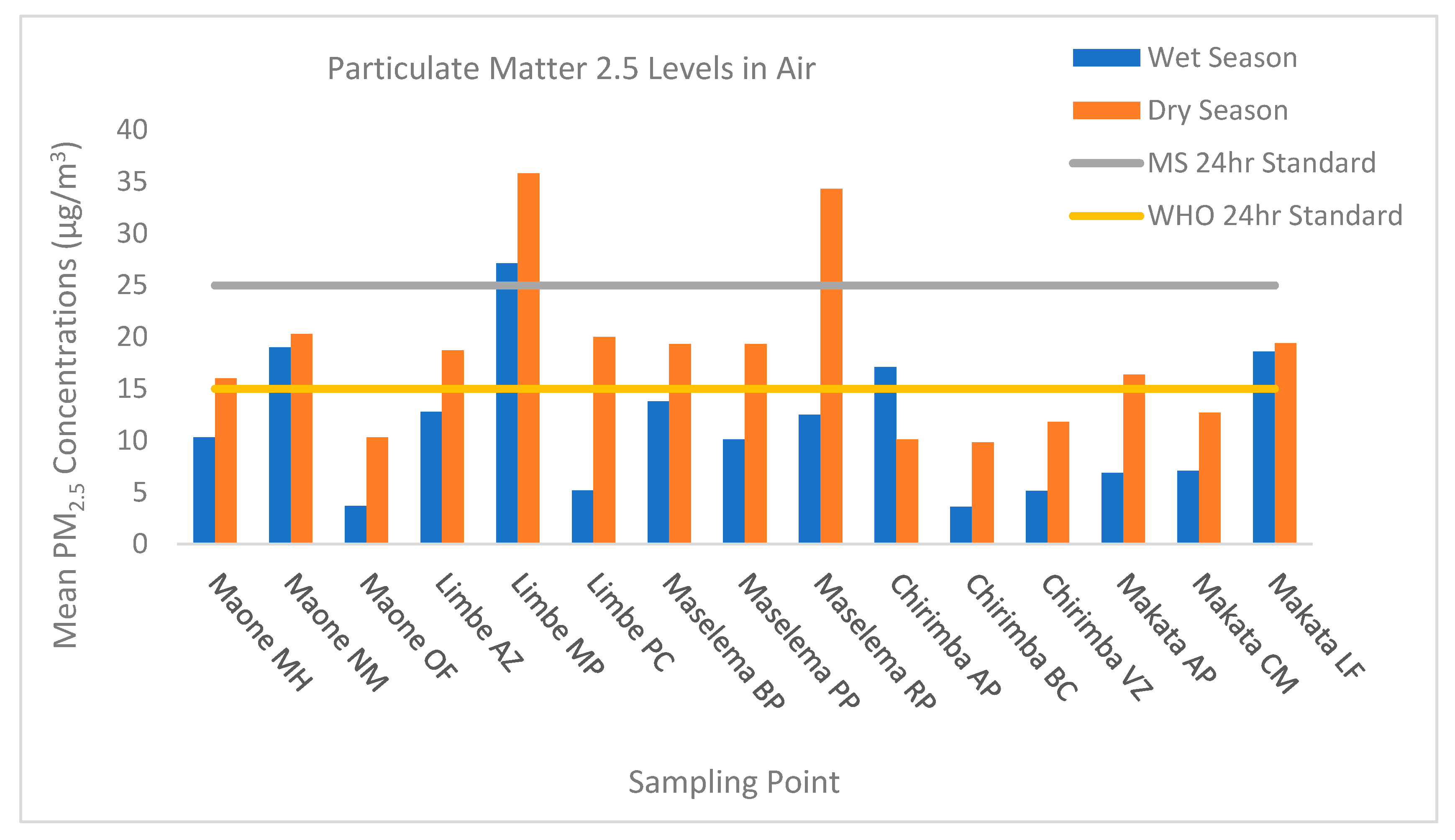

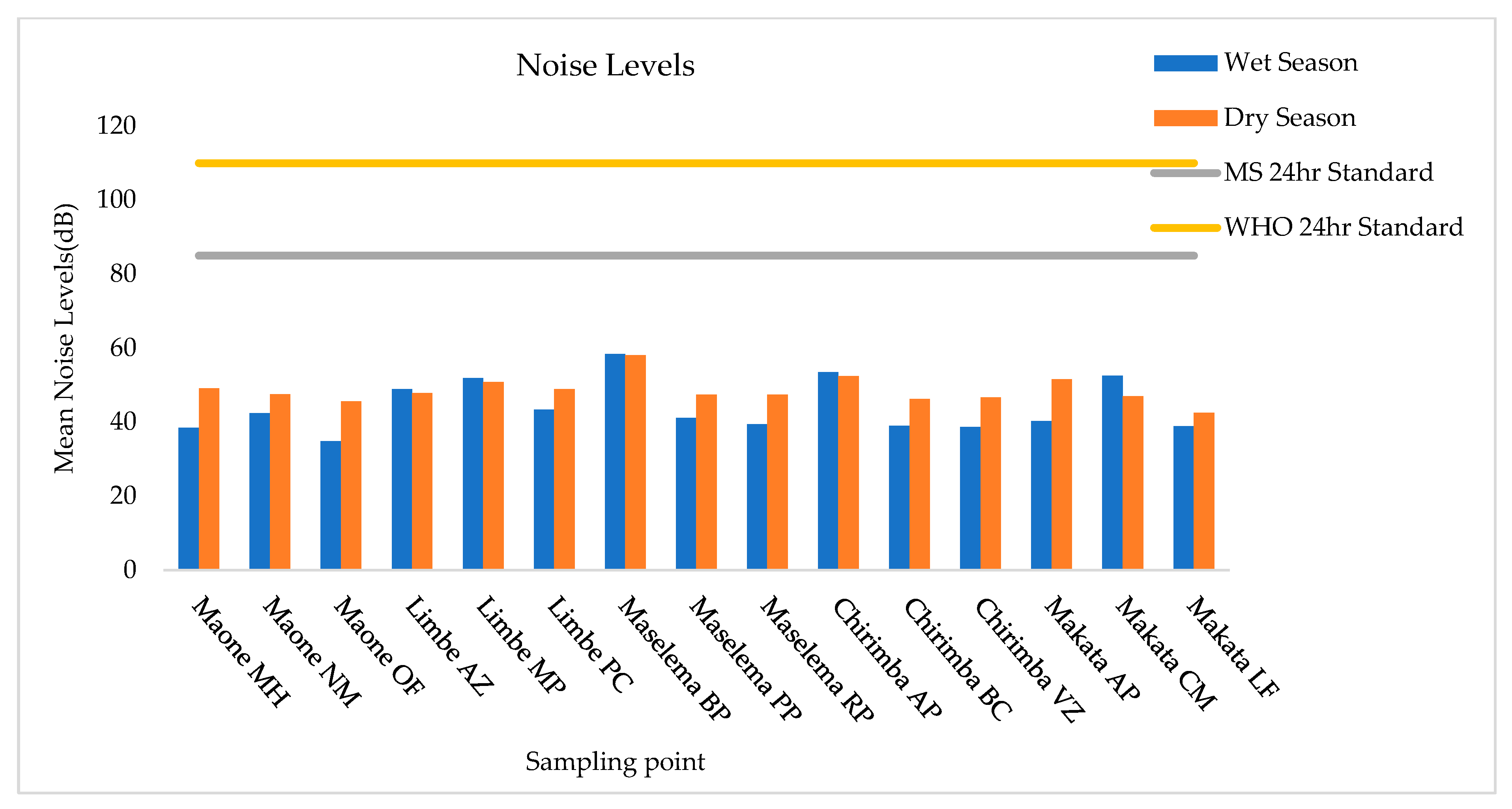


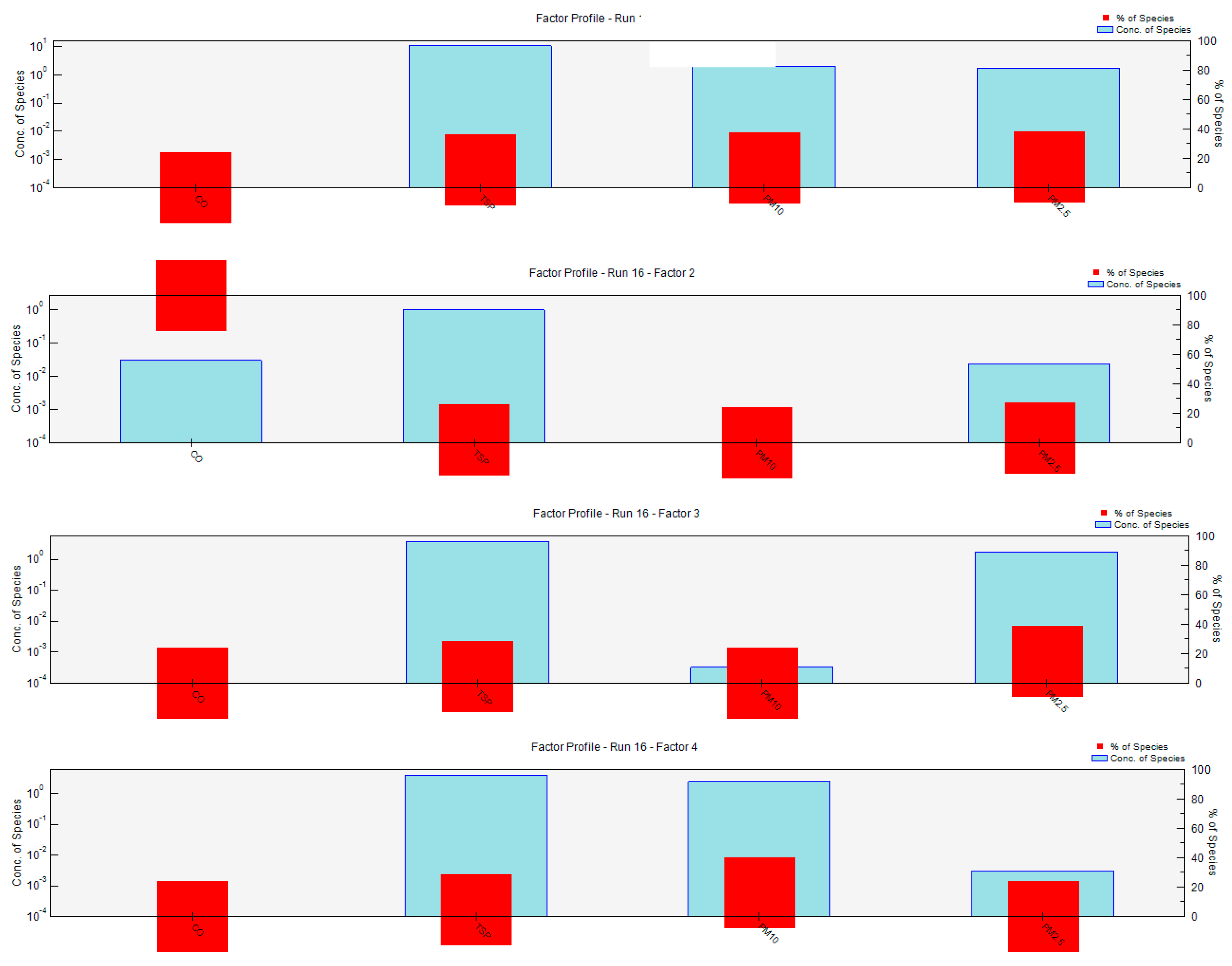


| Sampling Point | CO (mg/m3) | TSP (µg/m3) | PM10 (µg/m3) | PM2.5 (µg/m3) | Noise (dB) | |||||
|---|---|---|---|---|---|---|---|---|---|---|
| Wet Season | Dry Season | Wet Season | Dry Season | Wet Season | Dry Season | Wet Season | Dry Season | Wet Season | Dry Season | |
| Maone MH | 0 ± 0.00 | 0 ± 0.00 | 30.5 ± 13.37 | 112 ± 39.02 | 13.8 ± 2.70 | 21.3 ± 8.41 | 10.3 ± 2.61 | 16 ± 6.21 | 38.5 ± 5.90 | 49.1 ± 10.23 |
| Maone NM | 0.667 ± 0.58 | 1.7 ± 1.13 | 45.4 ± 19.97 | 95.9 ± 29.47 | 25.4 ± 11.25 | 27 ± 12.98 | 19 ± 8.35 | 20.3 ± 9.80 | 42.4 ± 8.26 | 47.5 ± 3.88 |
| Maone OF | 0 ± 0.00 | 0 ± 0.00 | 15 ± 6.10 | 75.7 ± 9.00 | 5.33 ± 1.89 | 13.6 ± 3.65 | 3.67 ± 1.36 | 10.3 ± 2.65 | 34.8 ± 1.30 | 45.6 ± 1.22 |
| Limbe AZ | 0 ± 0.00 | 0 ± 0.00 | 66.3 ± 52.10 | 105 ± 44.09 | 17 ± 15.97 | 24.7 ± 7.15 | 12.8 ± 11.87 | 18.7 ± 5.16 | 48.9 ± 2.24 | 47.8 ± 2.58 |
| Limbe MP | 0.333 ± 0.58 | 1.67 ± 0.58 | 214 ± 76.46 | 147 ± 37.82 | 36.2 ± 17.72 | 47.8 ± 16.68 | 27.1 ± 13.32 | 35.8 ± 12.58 | 51.9 ± 2.82 | 50.8 ± 5.99 |
| Limbe PC | 0 ± 0.00 | 0 ± 0.00 | 23.9 ± 14.11 | 115 ± 11.57 | 6.93 ± 3.52 | 26.6 ± 6.65 | 5.17 ± 2.63 | 20 ± 4.95 | 43.4 ± 6.02 | 48.9 ± 6.26 |
| Maselema BP | 2 ± 3.46 | 4.33 ± 2.31 | 174 ± 90.06 | 184 ± 114.00 | 18.3 ± 8.24 | 25.7 ± 7.91 | 13.8 ± 6.17 | 19.3 ± 5.91 | 58.4 ± 1.69 | 58.1 ± 2.69 |
| Maselema PP | 2.67 ± 3.06 | 3.67 ± 2.08 | 46.7 ± 25.67 | 184 ± 5.86 | 13.5 ± 7.82 | 25.7 ± 4.49 | 10.1 ± 5.84 | 19.3 ± 3.30 | 41.1 ± 1.10 | 47.4 ± 1.14 |
| Maselema RP | 1.33 ± 1.53 | 3 ± 2.00 | 44.9 ± 20.32 | 105 ± 27.59 | 4.3 ± 0.17 | 45.7 ± 13.36 | 12.5 ± 15.93 | 34.3 ± 10.00 | 39.4 ± 1.83 | 47.4 ± 3.32 |
| Chirimba AP | 0 ± 0.00 | 0.667 ± 1.15 | 319 ± 319.35 | 52.3 ± 5.61 | 23.1 ± 17.63 | 13.6 ± 5.98 | 17.1 ± 13.34 | 10.1 ± 4.61 | 53.5 ± 2.47 | 52.4 ± 5.09 |
| Chirimba BC | 0.33 ± 0.58 | 1.33 ± 0.58 | 18.3 ± 5.44 | 76.3 ± 37.86 | 5.07 ± 1.01 | 13.3 ± 6.91 | 3.6 ± 0.85 | 9.83 ± 5.27 | 39 ± 3.60 | 46.2 ± 0.67 |
| Chirimba VZ | 0 ± 0.00 | 0 ± 0.00 | 26.4 ± 6.92 | 68.7 ± 15.72 | 7.03 ± 2.03 | 15.7 ± 1.81 | 5.13 ± 1.46 | 11.8 ± 1.32 | 38.7 ± 3.95 | 46.7 ± 1.93 |
| Makata AP | 0 ± 0.00 | 1.33 ± 0.58 | 22 ± 6.75 | 51 ± 20.44 | 9.23 ± 2.35 | 21.6 ± 19.92 | 6.87 ± 1.76 | 16.4 ± 14.85 | 40.3 ± 2.27 | 51.6 ± 3.23 |
| Makata CM | 0 ± 0.00 | 0.667 ± 1.15 | 41 ± 3.79 | 50.4 ± 29.98 | 9.5 ± 2.51 | 17.1 ± 15.70 | 7.1 ± 1.91 | 12.7 ± 11.84 | 52.5 ± 4.82 | 47 ± 1.96 |
| Makata LF | 0 ± 0.00 | 1.33 ± 0.58 | 188 ± 272.32 | 75.6 ± 22.86 | 25.1 ± 27.10 | 25.9 ± 11.34 | 18.6 ± 20.50 | 19.4 ± 8.66 | 38.9 ± 5.53 | 42.5 ± 0.66 |
| Malawi Standard | 10 mg/m3 | 230 µg/m3 | 150 µg/m3 | 25 µg/m3 | 85 dB | |||||
| WHO Standard | 10 mg/m3 | N/A | 45 µg/m3 | 15 µg/m3 | 110 dB |
| Variable | Noise Level | |
|---|---|---|
| Dry Season | Wet Season | |
| CO | 0.205 (0.177) | 0.062 (0.687) |
| TSP | 0.241 (0.110) | 0.401 (0.006) |
| PM10 | 0.011 (0.941) | 0.358 (0.016) |
| PM2.5 | 0.011 (0.942) | 0.306 (0.041) |
Disclaimer/Publisher’s Note: The statements, opinions and data contained in all publications are solely those of the individual author(s) and contributor(s) and not of MDPI and/or the editor(s). MDPI and/or the editor(s) disclaim responsibility for any injury to people or property resulting from any ideas, methods, instructions or products referred to in the content. |
© 2024 by the authors. Licensee MDPI, Basel, Switzerland. This article is an open access article distributed under the terms and conditions of the Creative Commons Attribution (CC BY) license (https://creativecommons.org/licenses/by/4.0/).
Share and Cite
Utsale, C.C.; Kaonga, C.C.; Thulu, F.G.D.; Kosamu, I.B.M.; Thomson, F.; Chitete-Mawenda, U.; Sakugawa, H. Source Apportionment of Air Quality Parameters and Noise Levels in the Industrial Zones of Blantyre City. Air 2024, 2, 122-141. https://doi.org/10.3390/air2020008
Utsale CC, Kaonga CC, Thulu FGD, Kosamu IBM, Thomson F, Chitete-Mawenda U, Sakugawa H. Source Apportionment of Air Quality Parameters and Noise Levels in the Industrial Zones of Blantyre City. Air. 2024; 2(2):122-141. https://doi.org/10.3390/air2020008
Chicago/Turabian StyleUtsale, Constance Chifuniro, Chikumbusko Chiziwa Kaonga, Fabiano Gibson Daud Thulu, Ishmael Bobby Mphangwe Kosamu, Fred Thomson, Upile Chitete-Mawenda, and Hiroshi Sakugawa. 2024. "Source Apportionment of Air Quality Parameters and Noise Levels in the Industrial Zones of Blantyre City" Air 2, no. 2: 122-141. https://doi.org/10.3390/air2020008





